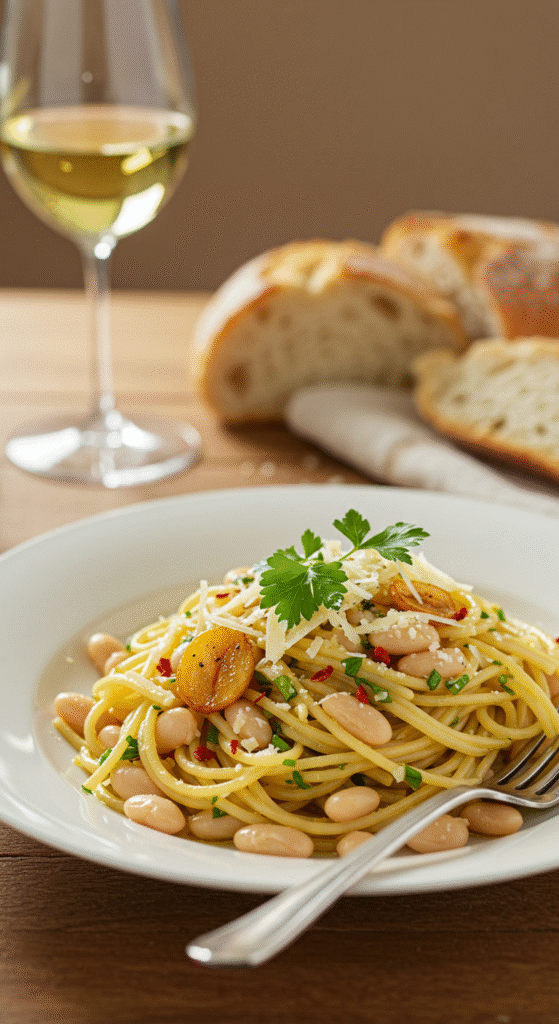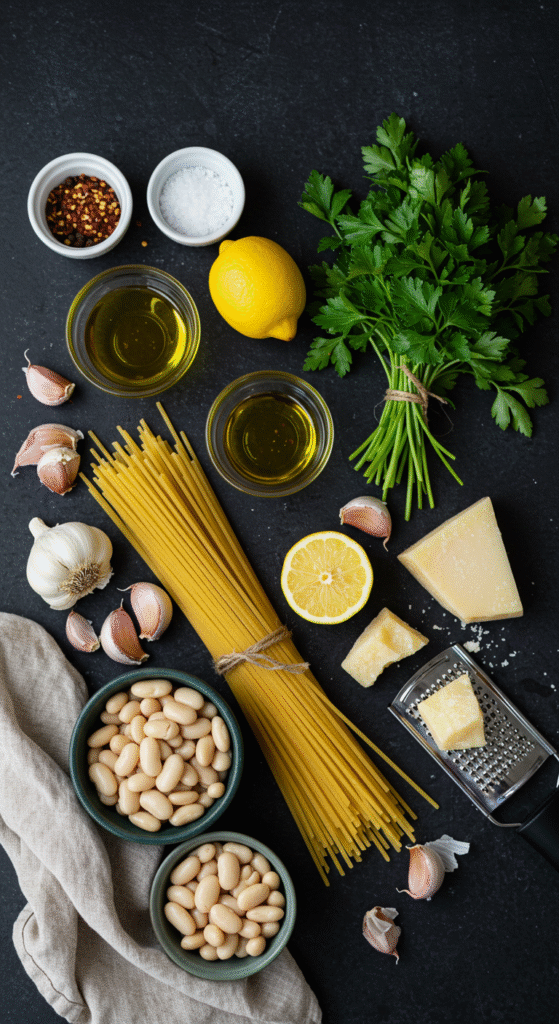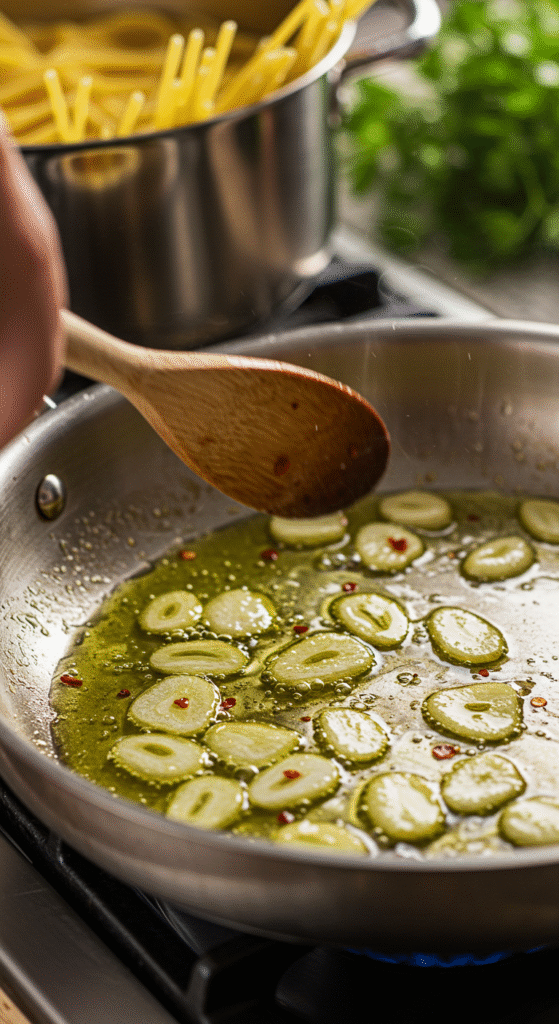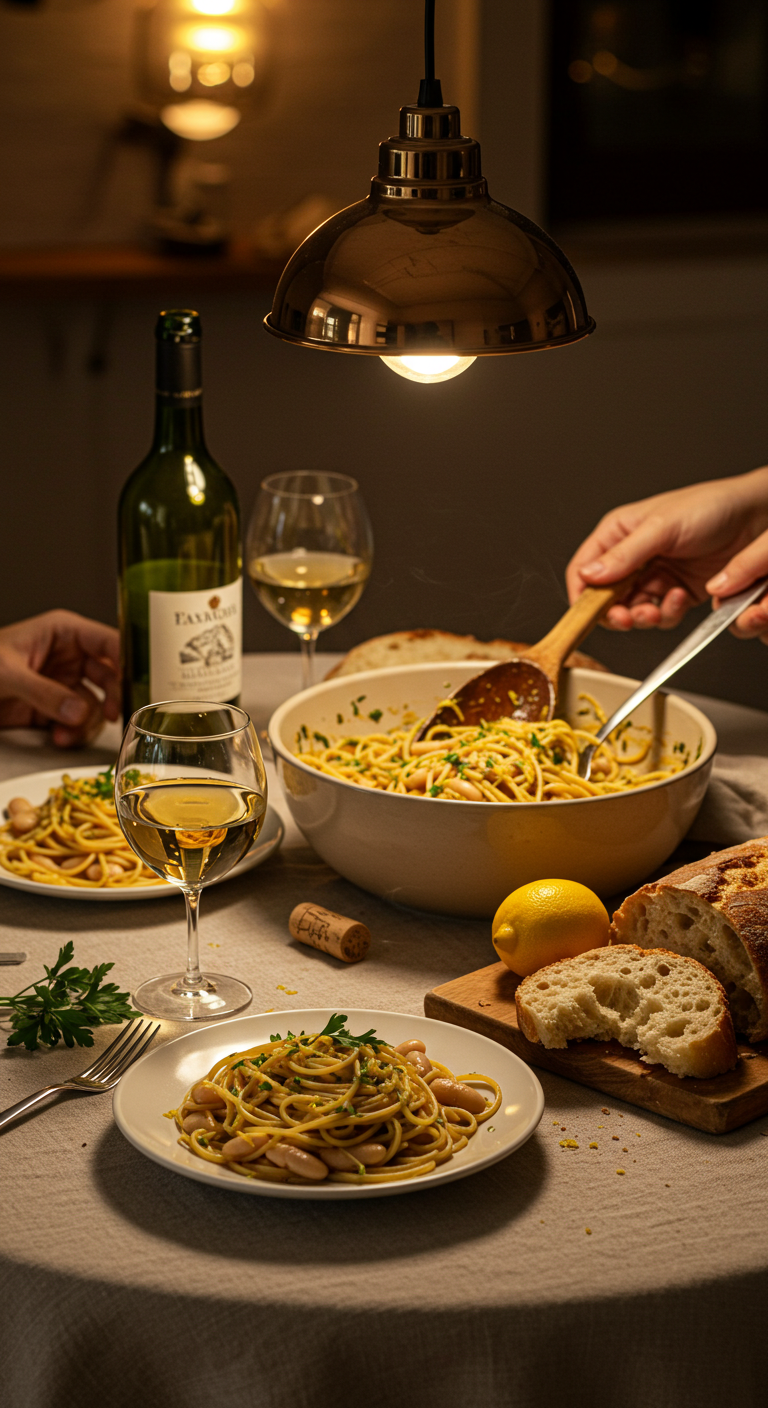Ever stood over a pan of sizzling garlic and olive oil and thought—this is it, this is the smell of happiness? That sharp, nutty perfume that fills your kitchen in seconds. Now imagine that classic Italian moment—Spaghetti Aglio e Olio—but with a twist: creamy white beans swirled right in. It’s humble, rustic, a little rebellious. And honestly? It’s the kind of meal that makes you feel like a magician with just a handful of pantry staples.
This dish isn’t trying too hard. It doesn’t need to. Garlic. Olive oil. Spaghetti. A pinch of heat. And those creamy cannellini or navy beans that turn a simple pasta into something soul-hugging. If regular Aglio e Olio is a quick midnight supper, this one’s its more sophisticated cousin—the one who knows good olive oil by taste and keeps a pepper grinder on the counter.

Why It’s Special
There’s something deeply comforting about turning ordinary ingredients into something extraordinary. Spaghetti Aglio e Olio is the epitome of that philosophy—a dish born out of necessity that still manages to taste luxurious. The white beans add body, creaminess, and protein, making this not just fast food but real, nourishing food.
It’s Italian cucina povera at its best—the art of doing more with less. You’ve got the simplicity of Naples (where this dish has its roots) meeting the gentle creaminess of Tuscan beans. The result? A bowl that hits every note: garlicky, nutty, silky, and just a little fiery.
And if you’re the kind who loves a meal that’s ready in 20 minutes yet tastes like you spent all afternoon crafting it—this one’s for you.
Ingredients & Substitutions

The magic of this recipe lies in how flexible it is. You probably already have most of what you need. But like any good Italian dish, quality matters—each ingredient pulls its weight.
For the Base:
- Spaghetti – Traditional and perfect for this recipe. Linguine or bucatini work too. Whole wheat or gluten-free? Go for it.
- Olive Oil – This is your star. Use a good extra-virgin one for flavor, and don’t be shy with it. The oil is the sauce here.
The Flavor Backbone:
- Garlic – Thinly sliced, not minced. You want golden slivers, not burnt bits.
- Crushed Red Pepper Flakes – A gentle kick. Adjust to your heat level—or skip it if you’re spice-sensitive.
The Twist:
- White Beans – Cannellini, Great Northern, or navy beans all work. They bring protein, creaminess, and a lovely texture. Canned beans are fine—just rinse and drain. Want extra flavor? Use home-cooked beans simmered with bay leaves and garlic.
For Depth & Finish:
- Parsley – Freshly chopped, for that herbal lift.
- Lemon Zest or Juice – Totally optional, but a squeeze of lemon brightens the whole dish.
- Parmesan (or Pecorino Romano) – Grated on top, for that salty, nutty finish. Skip it for a vegan version.
Substitutions:
- Oil alternatives: Avocado oil works, though you’ll lose some of that Italian soul.
- Garlic alternative: Try roasted garlic for a milder flavor or shallots for something different.
- Beans: Chickpeas add a nutty vibe; butter beans make it extra creamy.
- Herbs: Basil or arugula can replace parsley if that’s what’s in your fridge.
Expert Tip: Warm your serving bowls before plating. Hot pasta + warm dish = longer-lasting perfect texture.
Step-by-Step Instructions

Here’s where the alchemy happens. Garlic meets oil, spaghetti meets salt water, and you—yes you—become a pasta whisperer.
Step 1: Boil the Pasta
Bring a big pot of salted water to a rolling boil. It should taste like the sea. Cook your spaghetti until just al dente—it’ll finish cooking in the sauce. Save a good cup of that starchy pasta water before draining. It’s liquid gold.
Step 2: Infuse the Oil
In a large skillet, pour in your olive oil—generously. Add thinly sliced garlic and red pepper flakes to the cold oil. Turn the heat to medium. Let it slowly sizzle. You want to coax out the flavor, not shock the garlic into burning.
When the garlic turns golden (not brown—brown is bitter!), pull the pan off the heat for a second.
Step 3: Add the Beans
Toss in your rinsed white beans. Stir gently to coat them in that aromatic oil. Let them warm through, about a minute or two. The beans should soak up the garlic flavor like tiny sponges.
Step 4: Bring It Together
Add your drained spaghetti straight into the skillet. Toss well. Now pour in a splash of that reserved pasta water—start with ¼ cup. The starch helps the oil emulsify into a silky sauce that clings to every strand.
Keep tossing. Add a bit more water if needed, until it looks glossy and luscious.
Step 5: Finish Strong
Stir in chopped parsley and a sprinkle of salt. Maybe a crack of black pepper. Taste it—does it sing? If not, a drizzle more olive oil or a squeeze of lemon will wake it right up.
Step 6: Serve & Admire
Plate it up. Finish with grated Parmesan and maybe a few extra chili flakes if you like living on the edge.
Variations:
- Spicy Lover: Double the chili flakes and add a pinch of smoked paprika.
- Vegan Version: Skip the cheese or sub with nutritional yeast.
- Greens Upgrade: Toss in baby spinach or kale during the last minute of cooking.
- Seafood Twist: Add sautéed shrimp or anchovies for extra depth.
Pro Tip: Never rinse your pasta after boiling. You’ll wash away the starch that helps bind your sauce.
Cooking Techniques & Science

You might wonder: why start the garlic in cold oil? Because slow heat means the garlic infuses the oil deeply without scorching. Think of it like steeping tea—you’re drawing out the flavor gently.
The pasta water trick is another small miracle of chemistry. The starch from the noodles turns the oil and water into a light emulsion. That’s why true Aglio e Olio doesn’t feel greasy—it feels silky.
And those white beans? They add a different kind of magic. As they warm, their starch mingles with the oil and water, thickening the sauce naturally. That’s why you’ll see that beautiful glossy coating on your pasta. No cream. No butter. Just smart technique.
Use a wide skillet for tossing—it gives the pasta room to move, helping the sauce coat evenly. A pair of tongs is your best friend here. They’re better than a spoon for catching every swirl and strand.
👉 Recipe Card
Spaghetti Aglio e Olio with White Beans
Prep Time: 10 minutes
Cook Time: 15 minutes
Total Time: 25 minutes
Servings: 4
Ingredients
- 12 oz spaghetti
- ⅓ cup extra virgin olive oil
- 5 cloves garlic, thinly sliced
- ½ tsp crushed red pepper flakes (adjust to taste)
- 1 ½ cups cooked white beans (or 1 can, rinsed and drained)
- ¼ cup chopped fresh parsley
- ½ cup grated Parmesan or Pecorino Romano
- Salt and black pepper to taste
- ½ lemon (juice and zest, optional)
- Reserved pasta water as needed
Instructions
- Boil spaghetti in salted water until al dente. Reserve 1 cup of the pasta water, then drain.
- In a large skillet, add olive oil, garlic, and chili flakes to cold oil. Heat gently until the garlic turns golden.
- Add white beans and toss to coat in the flavored oil. Cook for 2 minutes.
- Add cooked pasta and a splash of pasta water. Toss to emulsify and form a glossy sauce.
- Stir in parsley, salt, and black pepper. Adjust consistency with more water if needed.
- Serve hot, topped with Parmesan and a squeeze of lemon if desired.
Nutrition (per serving):
Calories: ~480 | Protein: 15g | Carbs: 55g | Fat: 18g | Fiber: 8g
Serving & Pairing Suggestions

This pasta is satisfying on its own, but it loves good company. Serve it with a crisp green salad—something lemony with shaved fennel or arugula.
Crusty bread? Absolutely. It’s a crime to waste that garlicky oil left in the bowl. Mop it up proudly.
Wine pairing? A dry white like Pinot Grigio or Vermentino keeps things fresh. If you prefer red, a light-bodied Chianti won’t overpower the garlic.
For a more rustic meal, pair with roasted vegetables—zucchini, peppers, or even blistered cherry tomatoes for a pop of sweetness.
And if you’re making it for guests, finish each bowl with a drizzle of your best olive oil. The sheen alone makes people think you’ve been trained in Naples.
Conclusion
Spaghetti Aglio e Olio with White Beans is proof that you don’t need a dozen ingredients to make something divine. It’s about restraint, rhythm, and respect for what you’ve got. The garlic and oil do the heavy lifting, the beans lend heart, and the pasta ties it all together.
Every time you toss those strands in the pan, you’re part of a centuries-old conversation—Italian cooks making magic out of nothing. And now it’s yours to pass on, tweak, and make your own.
Next time you’re staring at your pantry thinking there’s “nothing to eat,” remember this recipe. There’s always garlic. There’s always olive oil. And there’s always a way to turn humble into heavenly.
FAQs
1. Can I use another type of pasta?
Absolutely. Linguine, fettuccine, or even short pasta like penne works. Just adjust cooking time and keep the sauce-to-pasta ratio balanced.
2. What if I don’t like spicy food?
Skip the red pepper flakes entirely. The dish will still shine from the garlic and oil alone.
3. Can I make it vegan?
Yes—simply omit the cheese or swap it for nutritional yeast. The beans provide plenty of richness.
4. How do I store leftovers?
Store in an airtight container for up to 3 days. Add a splash of water or olive oil when reheating to revive the sauce.
5. Can I use dry beans instead of canned?
Definitely. Cook them ahead with aromatics like garlic, onion, and bay leaves for more depth. Just make sure they’re tender before adding to the pasta.
Pinterest Description:
A cozy Italian classic gets a creamy, protein-packed upgrade! This Spaghetti Aglio e Olio with White Beans is garlicky, silky, and ready in under 30 minutes—pure pantry magic. Perfect for weeknights or impressing guests.
Image Prompt:
A shallow white bowl of spaghetti twirled with olive oil and white beans, glistening under soft light. Sprinkled with parsley, garlic slivers visible, a fork resting beside, and a drizzle of golden oil on top.

Selena is an experienced lifestyle blogger and the voice behind many of Cozy Toned’s inspiring posts. With a passion for mindful living, home styling, and everyday wellness, she shares practical tips and fresh ideas to help readers live beautifully and intentionally.
